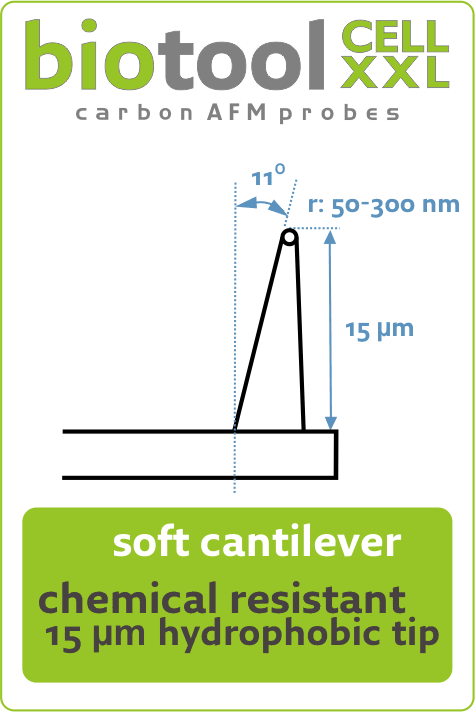
Last exhibition day at APS Physics March.Fri Mar 10 2023
Last exhibition day at APS Physics March. So far it has been fantastic! It’s so refreshing to see all the smiles again - the vibe here is highest I’ve seen in a decade;-)! All #AFMProbes from 8 different Brands available from our huge stock! NanoAndMoreNanoAndMore USA booth # 629 #apsmarch, @APSMeetings
Today, Thursday, March 9, 10 a.m.–4 p.m.
Caesars Forum Convention Center, Las Vegas, Nevada.


オリンパス製カンチレバーの国内販売を開始しましたWed Mar 08 2023
株式会社NanoAndMoreジャパンはオリンパス社と代理店契約を結び、オリンパス社製カンチレバー販売を行う国内代理店となりました。オリンパス製カンチレバーを弊社からもお買い求めいただけます。 さらに豊富なラインナップでお客様の多彩なご要望にお応えします。


AFM cantilevers HQ:CSC38/Al BS with nom. C=0.03N/m used in a studyTue Mar 07 2023
Fine defect engineering of graphene friction with imaging and nanotribology support from our softest silicon AFM cantilevers HQ:CSC38/Al BS with nom. C=0.03N/m.


Meet NanoWorld® at APS March 2023 in Las VegasTue Mar 07 2023
NanoWorld AG CEO Manfred Detterbeck is @NanoAndMore USA booth # 629 @APS March Meeting @APSphysics #apsmarch, which is currently being held from March 5–10, 2023 at Caesars Forum Convention Center, Las Vegas, Nevada. Will we meet you there too?

NanoAndMore USA booth no. 629 is all set up and ready to welcome you at APS PhysicsTue Mar 07 2023
NanoAndMoreNanoAndMore USA booth no. 629 is all set up and ready to welcome you at APS Physics (American Physical Society)
#apsmarch in Las Vegas at Caesars Forum Convention Center this week.
NanoWorld CEO Manfred Detterbeck will also be in attendance. Have you spotted him already? Don't forget to drop in and check out with him and NanoAndMore CEO Nicholas Schacher what's new in #AFMprobes
Exhibition dates and opening hours:
Tuesday, March 7, 10 a.m.–5 p.m.
Wednesday, March 8, 10 a.m.–5 p.m.
Thursday, March 9, 10 a.m.–4 p.m.


NanoAndMore Europe is travelling againMon Mar 06 2023
NanoAndMore Europe is travelling again. Meet us at the 6th International Workshop on Advanced Atomic Force Microscopy Techniques, March 6-7th, 2023 at Potsdam University this week.


Let’s meet up at NanoAndMore booth # 629 at APS PhysicsFri Mar 03 2023
Just a few more days and we’ll be ready to welcome you at #apsmarch meeting in Las Vegas.
Will you be there too? Let’s meet up at NanoAndMore booth # 629


Olympus discontinued all their AFM probes in September 2022Tue Feb 28 2023
Did you know that Olympus discontinued all their AFM probes in September 2022?
We're glad to let you know that NanoAndMoreNanoAndMore has replacement options ranging from “perfect match” to “very good alternatives”.
Visit us for more information: https://www.nanoandmore.com/Olympus-replacement-AFM-probes

Last exhibition day at the Annual Biophysical Society Meeting 2023Tue Feb 21 2023
Last exhibition day at the Annual Biophysical Society Meeting 2023 in San Diego.
Don’t miss your chance to meet with NanoAndMore USA CEO Nicholas Schacher face-to-face at booth #810 to talk #AFMprobes with him and catch up on the latest news.
Opening hours today Tuesday, February 21 10:00 AM-4:00 PM
We are looking forward to your visit!

Second exibition day at the 67th Annual Biophysical Society Meeting 2023Mon Feb 20 2023
Second exibition day at the 67th Annual Biophysical Society Meeting 2023 in San Diego. We’re greeting you with some image of the first two days and are looking to discuss your #AFMprobes needs for your applications wi#scanningprobemicroscopy
Dr. Daniel Guntli from NanoWorld is also attending the conference. Have you spotted him already?
Opening hours for the exhibtion today Monday, February 20 10:00 AM-5:00 PM

67th Annual Biophysical SocietyMeeting 2023Sun Feb 19 2023
It’s the first exhibition day of the 67th Annual Biophysical SocietyMeeting 2023. We’re all set up at and ready to welcome you at booth no 810 and looking forward to share the latest #AFMprobes news with you
Opening hours today Sunday, February 19 10:00 AM-5:00 PM
See you soon!


Tap150Al-G soft tapping mode AFM probes used in a studyThu Feb 16 2023
Large-area self-standing covalent crystalline films in a liquid-liquid interfacial synthesis approach studied with our Tap150Al-G soft tapping mode AFM probes.

MikroMasch® HQ:NSC19/No Al AFM tips used in a studyMon Feb 13 2023
Our HQ:NSC19/No Al AFM tips probe the topography and nanoscale elastic surface modulus of perspiring soft robotics skin based on polarity-switching porous liquid-crystal membranes in PeakForce quantitative nanomechanical mapping mode (PF-QNM, Bruker Corporation).


Mechanobiology of Living Fibroblasts and Breast Cancer CellsThu Feb 02 2023
Discover how nanotools 15 µm long, conical biotool cell XXL custom-made with 50-300 nm radius and 11˚ tilt compensation was applied for nanomechanical characterization of sub-surface organelles.
- Title: 3D nanomechanical mapping of subcellular and sub-nuclear structures of living cells by multi-harmonic AFM with long-tip microcantilevers
- Authors: Efremov, Yuri M., Suter, Daniel M., Timashev, Peter S., Raman, Arvind
- Publication: Scientific Reports
- Publisher: Springer Nature
- Date: Jan 11, 2022


Happy New Lunar Year of the Rabbit!Sat Jan 21 2023
NANOSENSORS™ AFM probes wishes you all a happy, healthy and successful new lunar year of the rabbit.


Expertise and creativity!Thu Jan 19 2023
Within every piece of silicon crystal lies hidden an AFM probe. We have the right tools, expertise and creativity to carve it.
#AFMProbes #AtomicForceMicroscopy


OPUS 3XC-GG AFM probes used in a recent studyMon Jan 16 2023
Collagen piezoelectricity in osteogenesis imperfecta (brittle bone disease) is investigated with Piezoresponse Force Microscopy using the gold coated soft tapping mode AFM cantilever of our OPUS 3XC-GG AFM probes.


MikroMasch® wishes you a Merry Christmas and a Happy New Year!Thu Dec 22 2022
MikroMasch® wishes you a Merry Christmas and a Happy New Year!
#AFMprobes #AFM #AtomicForceMicroscopy #merrychristmas #happynewyear2023
#AFMprobes #AFM #AtomicForceMicroscopy #merrychristmas #happynewyear2023


Season’s Greetings from NANOSENSORS™ AFM probesThu Dec 22 2022
Season’s Greetings from NANOSENSORS AFM probes
It is again time to wish all users of our AFM probes Happy Holidays! Enjoy the holiday season with friends and family. We are looking forward to a new year with you.


















